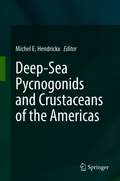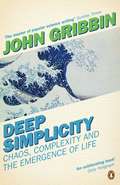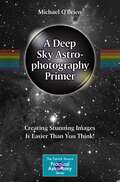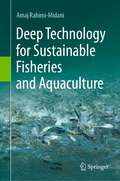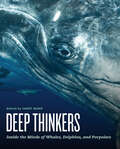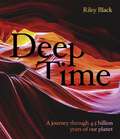- Table View
- List View
Deep-Sea Food Chains and the Global Carbon Cycle (Nato Science Series C: #360)
by G. T. Rowe Vita ParienteCarbon dioxide and other `greenhouse' gases are increasing in the atmosphere due to the burning of fossil fuels, the destruction of rain forests, etc., leading to predictions of a gradual global warming which will perturb the global biosphere. An important process which counters this trend toward potential climate change is the removal of carbon dioxide from the surface ocean by photosynthesis. This process packages carbon in phytoplankton which enter the food chain or sink into the deep sea. Their ultimate fate is a `rain' of organic debris out of the surface-mixed layer of the ocean. On a global scale, the mechanisms and overall rate of this process are poorly known. The authors of the 25 papers in this volume present their state-of-the-art approaches to quantifying the mechanisms by which the `rain' of biogenic debris nourishes deep ocean life. Prominent deep sea ecologists, geochemists and modelers address relationships between data and models of carbon fluxes and food chains in the deep ocean. An attempt is made to estimate the fate of carbon in the deep sea on a global scale by summing up the utilization of organic matter among all the populations of the abyssal biosphere. Comparisons are made between these ecological approaches and estimates of geochemical fluxes based on sediment trapping, one-dimensional geochemical models and horizontal (physical) input from continental margins. Planning interdisciplinary enterprises between geochemists and ecologists, including new field programs, are summarized in the final chapter. The summary includes a list of the important gaps in understanding which must be addressed before the role of the deep-sea biota in global-scale processes can be put in perspective.
Deep-Sea Mining: Resource Potential, Technical and Environmental Considerations
by Rahul SharmaThis comprehensive book contains contributions from specialists who provide a complete status update along with outstanding issues encompassing different topics related to deep-sea mining. Interest in exploration and exploitation of deep-sea minerals is seeing a revival due to diminishing grades and increasing costs of processing of terrestrial minerals as well as availability of several strategic metals in seabed mineral resources; it therefore becomes imperative to take stock of various issues related to deep-sea mining. The authors are experienced scientists and engineers from around the globe developing advanced technologies for mining and metallurgical extraction as well as performing deep sea exploration for several decades. They invite readers to learn about the resource potential of different deep-sea minerals, design considerations and development of mining systems, and the potential environmental impacts of mining in international waters.
Deep-Sea Mining and the Water Column: Advances, Monitoring and Related Issues
by Rahul SharmaThis book focuses on general issues of deep-sea mining for seafloor mineral deposits, as well as the scientific, technical, legal and policy issues related to impacts on the water column. The topic is a growing area of significance due to the ongoing conversations on this issue in the world community, in view of the large-scale consequences resulting from operations of different components of deep-sea mining systems. The chapters are divided in five sections, and are contributed by highly acclaimed scientists, technologists, lawyers and administrators who have decades of experience working on these topics. The information compiled in the book is expected to serve as an important reference for all stakeholders including researchers, contractors, mining companies, regulators and NGOs involved in deep-sea mining and marine environmental conservation. Section 1 provides an overall view of the current status of deep-sea mining and issues related to the water column. Section 2 looks at the engineering considerations for technology related to mining, handling of bulk solids in the marine environment, transporting the ores from seabed to shore as well as processing of deep-sea minerals. Section 3 discusses various approaches for assessment of impacts of deep-sea mining on the water column. Section 4 assesses the chemical, physical and biological characteristics of the water column in different oceans of the world. Finally, section 5 deals with legal, policy and economic aspects of deep-sea mining.
Deep-Sea Pycnogonids and Crustaceans of the Americas
by Michel E. HendrickxAmong the deep-sea marine invertebrates, pycnogonids and crustaceans represent ecologically important and most diverse groups of species. Yet both are still poorly understood. Sampling and exploring operations off the west and east coast of the Americas has significantly increased in the last two decades. However such operations are very costly and limited in number and frequency. In countries like Brazil, Canada, Chile, Colombia, Costa Rica, Mexico, Peru, the United States of America, and El Salvador a large effort has been made to explore the deep-sea resources and the rich diversity of the communities, resulting in a better understanding of the natural ecosystems on both coasts of America. Pycnogonids and many groups of deep-sea crustaceans have been intensively studied, from the smallest animals, like the mostly unknown benthic copepods to the largest decapods.This book presents new and updated information on various groups of deep-sea pycnogonids and crustaceans occurring off the American continent. Offering a valuable reference resource for scientists interested in this fascinating fauna, it includes review papers and new data on the deep-sea communities occurring off the USA, Mexico, El Salvador, Costa Rica, Colombia, Chile, Peru, Brazil and Argentina, as well as in larger areas in both the East Pacific and the West Atlantic. As such it covers most of the current deep-water research in Latin America.
Deep Sequencing Data Analysis (Methods in Molecular Biology #1038)
by Noam ShomronThe new genetic revolution is fuelled by Deep Sequencing (or Next Generation Sequencing) apparatuses which, in essence, read billions of nucleotides per reaction. Effectively, when carefully planned, any experimental question which can be translated into reading nucleic acids can be applied.In Deep Sequencing Data Analysis, expert researchers in the field detail methods which are now commonly used to study the multi-facet deep sequencing data field. These included techniques for compressing of data generated, Chromatin Immunoprecipitation (ChIP-seq), and various approaches for the identification of sequence variants. Written in the highly successful Methods in Molecular Biology series format, chapters include introductions to their respective topics, lists of necessary materials and reagents, step-by-step, readily reproducible protocols, and key tips on troubleshooting and avoiding known pitfalls. Authoritative and practical, Deep Sequencing Data Analysis seeks to aid scientists in the further understanding of key data analysis procedures for deep sequencing data interpretation.
Deep Sequencing Data Analysis (Methods in Molecular Biology #2243)
by Noam ShomronThis second edition provides new and updated chapters from expert researchers in the field detailing methods used to study the multi-facet deep sequencing data field. Chapters guide readers through techniques for processing RNA-seq data, microbiome analysis, deep learning methodologies, and various approaches for the identification of sequence variants. Written in the highly successful Methods in Molecular Biology series format, chapters include introductions to their respective topics, lists of the necessary materials and reagents, step-by-step, readily reproducible laboratory protocols, and tips on troubleshooting and avoiding known pitfalls. Authoritative and cutting-edge, Deep Sequencing Data Analysis: Methods and Protocols, Second Edition aims to ensure successful results in the further study of this vital field.
Deep Simplicity: Chaos, Complexity And The Emergence Of Life (Penguin Press Science Ser.)
by John Gribbin'Gribbin takes us through the basics with his customary talent for accessibility and clarity' Sunday Times The world around us can be a complex, confusing place. Earthquakes happen without warning, stock markets fluctuate, weather forecasters seldom seem to get it right - even other people continue to baffle us. How do we make sense of it all? In fact, John Gribbin reveals, our seemingly random universe is actually built on simple laws of cause and effect that can explain why, for example, just one vehicle braking can cause a traffic jam; why wild storms result from a slight atmospheric change; even how we evolved from the most basic materials. Like a zen painting, a fractal image or the pattern on a butterfly's wings, simple elements form the bedrock of a sophisticated whole. Synthesizing chaos and complexity theory for the perplexed, Deep Simplicity brilliantly illuminates the harmony underlying our existence.
A Deep Sky Astrophotography Primer: Creating Stunning Images Is Easier Than You Think! (The Patrick Moore Practical Astronomy Series)
by Michael O'BrienThis instructional guide has one aim: to teach inexperienced astrophotographers how to take high quality images. Often, basic information about astrophotography is lacking, or is dealt with too briefly in books on the subject. This book is a distillation of the author’s own experiences, bringing together everything you will need to make the fastest possible progress in deep-sky imaging. The book will teach you how to set up and use your astrophotography equipment in a systematic, easy-to-follow manner, helping you get started while avoiding common mistakes. With a step-by-step walk-through course and a unique observational guide to each object, the book contains a plethora of valuable, beginner-friendly information. Particularly useful is the chapter on troubleshooting, which will help newcomers avoid further frustration when things just don’t seem to go right! The book also contains a number of easy to advanced DIY projects for imagers working on a budget.
The Deep-Sky Observer’s Year: A Guide to Observing Deep-Sky Objects Throughout the Year (The Patrick Moore Practical Astronomy Series)
by Paul ParsonsDeep-sky observing is easily the most popular field for amateur astronomers. The big problem faced by non-professional observers is what to look at - what is visible at a particular time of year. The Deep-Sky Observers Year is a month-by-month guide to the best objects to view. Objects are given a "star rating" according to how difficult they are to observe or image with a particular size of telescope. The book includes many images produced by amateur astronomers, as well as photographs from NASA, ESA, and ESO. There is background information about the objects, along with lots of useful tips, hints, and resources.
Deep Sky Observing: The Astronomical Tourist (The Patrick Moore Practical Astronomy Series)
by Steve R. CoeSteve Coe has been watching the deep sky from locations near his home in Arizona for almost 20 years. During that time he has accumulated a wealth of knowledge, observations, hints and tips that will help every deep sky observer, regardless of experience.This, his first book, gives detailed practical advice about how to find the best observing site, how to make the most of the time spent there, and what equipment and instruments to take along. There are comprehensive lists of deep sky objects of all kinds, along with Steve's own observations describing how they look through telescopes with apertures ranging from 8 to 36 inches (0.2 - 0.9 m).Most of all, this book is all about how to enjoy astronomy. Steve's enthusiasm and sense of wonder shine through every page as he invites you along on a tour of some of the most beautiful and fascinating sites in the deep sky.
Deep Sky Observing: An Astronomical Tour (The Patrick Moore Practical Astronomy Series)
by Steven R. CoeThis updated second edition has all of the information needed for your successful forays into deep sky observing. Coe uses his years of experience to give detailed practical advice about how to find the best observing site, how to make the most of the time spent there, and what equipment and instruments to take along. There are comprehensive lists of deep sky objects of all kinds, along with Steve's own observations describing how they look through telescopes with apertures ranging from 4 inches to 36 inches (0.1 - 0.9 meters).Binocular observing also gets its due, while the lists of objects have been amended to highlight only the best targets. A new index makes finding targets easier than ever before, while the selection of viewing targets has been revised from the first edition. Most of all, this book is all about how to enjoy astronomy. The author's enthusiasm and sense of wonder shine through every page as he invites you along on a tour of some of the most beautiful and fascinating sites in the deep sky, with the improved object list making sure your choice of a faint cluster, hazy nebula or distant galaxy will all be equally rewarding.
Deep-Sky Video Astronomy (The Patrick Moore Practical Astronomy Series)
by Steve Quirk Steve MasseyDeep-Sky Video Astronomy is a concise guide to using modern integrating video cameras for deep-sky viewing and imaging with the kinds of modest telescopes available commercially to amateur astronomers. It includes an introduction and a brief history of the technology, camera types, etc. The authors then examine the pros and cons of this unrefrigerated yet highly efficient technology, which is already beginning to compete with expensive astronomical cooled-chip CCD cameras in quality and ease of use. There is a thorough examination of accessories used to achieve particular results. Examples are focal reducers, Barlow lenses, and optical filters. However, the focus is mostly on the practical side of creating beautiful and detailed astronomical portraits using image-stacking software, enhancement tools like PhotoShop, and creating color images with a black-and-white camera. Practical step-by-step examples supported by tried and trusted tips show how to achieve the best possible deep-sky video portrait!
Deep Space Craft: An Overview of Interplanetary Flight (Springer Praxis Books)
by Dave DoodyDeep Space Craft opens the door to interplanetary flight. It looks at this world from the vantage point of real operations on a specific mission, and follows a natural trail from the day-to-day working of this particular spacecraft, through the functioning of all spacecraft to the collaboration of the various disciplines to produce the results for which a spacecraft is designed. These results are of course mostly of a scientific nature, although a small number of interplanetary missions are also flown primarily to test and prove new engineering techniques. The author shows how, in order to make sense of all the scientific data coming back to Earth, the need for experiments and instrumentation arises, and follows the design and construction of the instruments through to their placement and testing on a spacecraft prior to launch. Examples are given of the interaction between an instrument’s science team and the mission’s flight team to plan and specify observations, gather and analyze data in flight, and finally present the results and discoveries to the scientific community. This highly focused, insider’s guide to interplanetary space exploration uses many examples of previous and current endeavors. It will enable the reader to research almost any topic related to spacecraft and to seek the latest scientific findings, the newest emerging technologies, or the current status of a favorite flight. In order to provide easy paths from the general to the specific, the text constantly refers to the Appendices. Within the main text, the intent is general familiarization and categorization of spacecraft and instruments at a high level, to provide a mental framework to place in context and understand any spacecraft and any instrument encountered in the reader’s experience. Appendix A gives illustrated descriptions of many interplanetary spacecraft, some earth-orbiters and ground facilities to reinforce the classification framework. Appendix B contains illustrated detailed descriptions of a dozen scientific instruments, including some ground-breaking engineering appliances that have either already been in operation or are poised for flight. Each instrument’s range of sensitivity in wavelengths of light, etc, and its physical principle(s) of operation is described. Appendix C has a few annotated illustrations to clarify the nomenclature of regions and structures in the solar system and the planets’ ring systems, and places the solar system in context with the local interstellar environment.
Deep Space Flight and Communications: Exploiting the Sun as a Gravitational Lens (Springer Praxis Books)
by Claudio MacconeThe majority of books dealing with prospects for interstellar flight tackle the problem of the propulsion systems that will be needed to send a craft on an interstellar trajectory. The proposed book looks at two other, equally important aspects of such space missions, and each forms half of this two part book. Part 1 looks at the ways in which it is possible to exploit the focusing effect of the Sun as a gravitational lens for scientific missions to distances of 550 AU and beyond into interstellar space. The author explains the mechanism of the Sun as a gravitational lens, the scientific investigations which may be carried out along the way to a distance of 550 AU (and at the 550 AU sphere itself), the requirements for exiting the Solar System at the highest speed and a range of project ideas for missions entering interstellar space. Part 2 of the book deals with the problems of communicating between an interstellar spaceship and the Earth, especially at very high speeds. Here the author assesses a range of mathematical tools relating to the Karhunen-Loève Transform (KLT) for optimal telecommunications, technical topics that may one day enable humans flying around the Galaxy to keep in contact with the Earth. This part of the book opens with a summary of the author’s 2003 Pešek Lecture presented at the IAC in Bremen, which introduces the concept of KLT for engineers and ‘newcomers’ to the subject. It is planned to include a DVD containing the full mathematical derivations of the KLT for those interested in this important mathematical tool whilst the text itself will contain the various results without outlines of the mathematical proofs. Astronautical engineers will thus be able to see the application of the results without getting bogged down in the mathematics.
Deep Space Probes: To the Outer Solar System and Beyond (Springer Praxis Books)
by Gregory L. MatloffThe Space Age is nearly 50 years old but exploration of the outer planets and beyond has only just begun. Deep-Space Probes Second Edition draws on the latest research to explain why we should explore beyond the edge of the Solar System and how we can build highly sophisticated robot spacecraft to make the journey. Many technical problems remain to be solved, among them propulsion systems to permit far higher velocities, and technologies to build vehicles a fraction of the size of today’s spacecraft. Beyond the range of effective radio control, robot vehicles for exploring deep space will need to be intelligent, ‘thinking’ craft – able to make vital decisions entirely on their own. Gregory Matloff also looks at the possibility for human travel into interstellar space, and some of the immense problems that such journeys would entail. This second edition includes an entirely new chapter on holographic message plaques for future interstellar probes – a NASA-funded project.
Deep-Space Probes (Springer Praxis Books)
by Greogory L. MatloffThis expert guide, written by a major figure at the NASA Marshall Spaceflight Center, presents an authoritative and comprehensive survey of the present-day state-of-the-art in the field of extrasolar and interstellar space exploration, focusing on the most promising techniques. It looks at potential missions and explores the many exciting ideas being developed to probe the planets and nearby stars for signs of life. Because of the tremendous current interest in the search for extrasolar life and extraterrestrial intelligence, this is a timely and illuminating survey.
Deep Space Propulsion: A Roadmap to Interstellar Flight (Astronomers' Universe Ser.)
by K. F. LongThe technology of the next few decades could possibly allow us to explore with robotic probes the closest stars outside our Solar System, and maybe even observe some of the recently discovered planets circling these stars. This book looks at the reasons for exploring our stellar neighbors and at the technologies we are developing to build space probes that can traverse the enormous distances between the stars.In order to reach the nearest stars, we must first develop a propulsion technology that would take our robotic probes there in a reasonable time. Such propulsion technology has radically different requirements from conventional chemical rockets, because of the enormous distances that must be crossed. Surprisingly, many propulsion schemes for interstellar travel have been suggested and await only practical engineering solutions and the political will to make them a reality. This is a result of the tremendous advances in astrophysics that have been made in recent decades and the perseverance and imagination of tenacious theoretical physicists. This book explores these different propulsion schemes – all based on current physics – and the challenges they present to physicists, engineers, and space exploration entrepreneurs. This book will be helpful to anyone who really wants to understand the principles behind and likely future course of interstellar travel and who wants to recognizes the distinctions between pure fantasy (such as Star Trek’s ‘warp drive’) and methods that are grounded in real physics and offer practical technological solutions for exploring the stars in the decades to come.
Deep Technology for Sustainable Fisheries and Aquaculture
by Amaj Rahimi-MidaniThis book uses real-world examples from the aquaculture industry to demonstrate how deep technology is assisting farmers and vulnerable communities. Works conducted by Poseidon-AI (a deep tech company involved in the aquaculture sector) in different countries are presented as case studies to show the positive impacts of deep tech involvement in the aquaculture sector. Primary industries, such as fisheries and aquaculture, rely heavily on labor. Furthermore, the manual practices of these farming methods increase material waste and reduce yields, resulting in higher costs and lower revenues. Poikilotherms make up the majority of aquatic animals, and environmental changes have a significant impact on them. This means that, due to climate change, farming of these animals cannot continue in the same way that it has for centuries. Artificial intelligence, machine learning, image processing, sensing, and automation are approaches that can assist these farms in dealing with rapid environmental changes while also assisting farmers in growing their businesses sustainably. This book is of interest to climate change scientists, entrepreneurs, investors, civil workers, and policymakers. Furthermore, the book is a great complimentary material for graduate students of fisheries, aquaculture, ecology, soil science, water management and environmental sciences. All national and international policymakers working in implementation of UNSDGs and sustainability, will find this book a useful read.
Deep Thinkers: Inside the Minds of Whales, Dolphins, and Porpoises
by Janet MannHumans aside, dolphins, whales, and porpoises are often considered to be the smartest creatures on Earth. Science and nature buffs are drawn to stories of their use of tools, their self-recognition, their beautiful and complex songs, and their intricate societies. But how do we know what we know, and what does it mean? In Deep Thinkers, renowned cetacean biologist Janet Mann gathers a gam of the world’s leading whale and dolphin researchers—including Luke Rendell, Hal Whitehead, and many more—to illuminate these vital questions, exploring the astounding capacities of cetacean brains. Diving into our current understanding of and dynamic research on dolphin and whale cognition, communication, and culture, Deep Thinkers reveals how incredibly sophisticated these mammals are—and how much we can learn about other animal minds by studying cetacean behavior. Through a combination of fascinating text and more than 150 beautiful and informative illustrations, chapters compare the intelligence markers of cetaceans with those of birds, bats, and primates, asking how we might properly define intelligence in nonhumans. As all-encompassing and profound as the seas in which these deep cetacean cultures have evolved, Deep Thinkers is an awesome and inspiring journey into the fathoms—a reminder of what we gain through their close study, and of what we lose when the great minds of the sea disappear.
Deep Thinkers: Inside the Minds of Whales, Dolphins, and Porpoises
by Janet MannHumans aside, dolphins, whales, and porpoises are often considered to be the smartest creatures on Earth. Science and nature buffs are drawn to stories of their use of tools, their self-recognition, their beautiful and complex songs, and their intricate societies. But how do we know what we know, and what does it mean? In Deep Thinkers, renowned cetacean biologist Janet Mann gathers a gam of the world’s leading whale and dolphin researchers—including Luke Rendell, Hal Whitehead, and many more—to illuminate these vital questions, exploring the astounding capacities of cetacean brains. Diving into our current understanding of and dynamic research on dolphin and whale cognition, communication, and culture, Deep Thinkers reveals how incredibly sophisticated these mammals are—and how much we can learn about other animal minds by studying cetacean behavior. Through a combination of fascinating text and more than 150 beautiful and informative illustrations, chapters compare the intelligence markers of cetaceans with those of birds, bats, and primates, asking how we might properly define intelligence in nonhumans. As all-encompassing and profound as the seas in which these deep cetacean cultures have evolved, Deep Thinkers is an awesome and inspiring journey into the fathoms—a reminder of what we gain through their close study, and of what we lose when the great minds of the sea disappear.
Deep Thinkers: Inside the Minds of Whales, Dolphins, and Porpoises
by Janet MannHumans aside, dolphins, whales, and porpoises are often considered to be the smartest creatures on Earth. Science and nature buffs are drawn to stories of their use of tools, their self-recognition, their beautiful and complex songs, and their intricate societies. But how do we know what we know, and what does it mean? In Deep Thinkers, renowned cetacean biologist Janet Mann gathers a gam of the world’s leading whale and dolphin researchers—including Luke Rendell, Hal Whitehead, and many more—to illuminate these vital questions, exploring the astounding capacities of cetacean brains. Diving into our current understanding of and dynamic research on dolphin and whale cognition, communication, and culture, Deep Thinkers reveals how incredibly sophisticated these mammals are—and how much we can learn about other animal minds by studying cetacean behavior. Through a combination of fascinating text and more than 150 beautiful and informative illustrations, chapters compare the intelligence markers of cetaceans with those of birds, bats, and primates, asking how we might properly define intelligence in nonhumans. As all-encompassing and profound as the seas in which these deep cetacean cultures have evolved, Deep Thinkers is an awesome and inspiring journey into the fathoms—a reminder of what we gain through their close study, and of what we lose when the great minds of the sea disappear.
Deep Thinkers: Inside the Minds of Whales, Dolphins, and Porpoises
Humans aside, dolphins, whales, and porpoises are often considered to be the smartest creatures on Earth. Science and nature buffs are drawn to stories of their use of tools, their self-recognition, their beautiful and complex songs, and their intricate societies. But how do we know what we know, and what does it mean? In Deep Thinkers, renowned cetacean biologist Janet Mann gathers a gam of the world’s leading whale and dolphin researchers—including Luke Rendell, Hal Whitehead, and many more—to illuminate these vital questions, exploring the astounding capacities of cetacean brains. Diving into our current understanding of and dynamic research on dolphin and whale cognition, communication, and culture, Deep Thinkers reveals how incredibly sophisticated these mammals are—and how much we can learn about other animal minds by studying cetacean behavior. Through a combination of fascinating text and more than 150 beautiful and informative illustrations, chapters compare the intelligence markers of cetaceans with those of birds, bats, and primates, asking how we might properly define intelligence in nonhumans. As all-encompassing and profound as the seas in which these deep cetacean cultures have evolved, Deep Thinkers is an awesome and inspiring journey into the fathoms—a reminder of what we gain through their close study, and of what we lose when the great minds of the sea disappear.
Deep Time: A journey through 4.5 billion years of our planet
by Riley BlackDeep time is the timescale of the geological events that have shaped our planet. Whilst so immense as to challenge human understanding, its evidence is nonetheless visible all around us. Through explanations of the latest research and over 200 fascinating images, Deep Time explores this evidence, from the visible layers in ancient rock to the hiss of static on the radio, and from fossilized shark's teeth to underwater forests. These relics of ancient epochs, many of which we can see and touch today, connect our present to the distant past and answer broader questions about our place in the timeline of the Earth.Charting 4.5 billion years of geological history, this is the story of our world, from its birth to the dawn of civilization.
Deep Time: A Literary History
by Noah HeringmanHow the concept of “deep time” began as a metaphor used by philosophers, poets, and naturalists in the eighteenth and nineteenth centuriesIn this interdisciplinary book, Noah Heringman argues that the concept of “deep time”—most often associated with geological epochs—began as a metaphorical language used by philosophers, poets, and naturalists of the eighteenth and nineteenth centuries to explore the origins of life beyond the written record. Their ideas about “the abyss of time” created a way to think about the prehistoric before it was possible to assign dates to the fossil record. Heringman, examining stories about the deep past by visionary thinkers ranging from William Blake to Charles Darwin, challenges the conventional wisdom that the idea of deep time came forth fully formed from the modern science of geology. Instead, he argues, it has a rich imaginative history.Heringman considers Johann Reinhold Forster and Georg Forster, naturalists on James Cook’s second voyage around the world, who, inspired by encounters with Pacific islanders, connected the scale of geological time to human origins and cultural evolution; Georges-Louis Leclerc, Comte de Buffon, who drew on travel narrative, antiquarian works, and his own fieldwork to lay out the first modern geological timescale; Blake and Johann Gottfried Herder, who used the language of fossils and artifacts to promote ancient ballads and “prehistoric song”; and Darwin’s exploration of the reciprocal effects of geological and human time. Deep time, Heringman shows, has figural and imaginative dimensions beyond its geological meaning.
Deep Time: A Literary History
by Noah HeringmanHow the concept of “deep time” began as a metaphor used by philosophers, poets, and naturalists in the eighteenth and nineteenth centuriesIn this interdisciplinary book, Noah Heringman argues that the concept of “deep time”—most often associated with geological epochs—began as a metaphorical language used by philosophers, poets, and naturalists of the eighteenth and nineteenth centuries to explore the origins of life beyond the written record. Their ideas about “the abyss of time” created a way to think about the prehistoric before it was possible to assign dates to the fossil record. Heringman, examining stories about the deep past by visionary thinkers ranging from William Blake to Charles Darwin, challenges the conventional wisdom that the idea of deep time came forth fully formed from the modern science of geology. Instead, he argues, it has a rich imaginative history.Heringman considers Johann Reinhold Forster and Georg Forster, naturalists on James Cook’s second voyage around the world, who, inspired by encounters with Pacific islanders, connected the scale of geological time to human origins and cultural evolution; Georges-Louis Leclerc, Comte de Buffon, who drew on travel narrative, antiquarian works, and his own fieldwork to lay out the first modern geological timescale; Blake and Johann Gottfried Herder, who used the language of fossils and artifacts to promote ancient ballads and “prehistoric song”; and Darwin’s exploration of the reciprocal effects of geological and human time. Deep time, Heringman shows, has figural and imaginative dimensions beyond its geological meaning.



